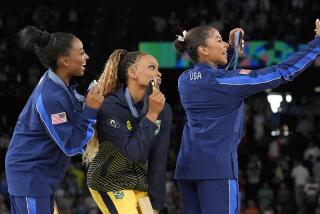Learning to Keep Women’s Injuries on the Run
- Share via
Ever heard of a three-step stop? It’s one move that doctors hope will help save women’s knees in basketball, soccer and other sports.
As coaches and trainers develop such techniques to help women protect themselves from sports injuries, researchers are trying to pinpoint why women are more prone than men to certain types of injuries, particularly of the knees. They’re exploring anatomical causes, such as looser joints stemming from female sex hormones, a wider pelvis and a tendency to land straight-legged when jumping.
While those factors play a role, the critical element may be that women tend to lack early sports training, said Dr. Lisa R. Callahan, medical director of the Women’s Sports Medicine Center at the Hospital for Special Surgery in New York. Without their muscles, tendons and nerves trained to respond to the demands of childhood athletics, women may be less physically conditioned than men.
Because organized sports have become so popular, coaches reach deeper into the pool of available young women, “many of whom weren’t out running around the block and climbing trees at 5, 6 and 7 years old and didn’t play a sport until much later,” said Dr. Angela Smith, an orthopedic surgeon in Philadelphia and president-elect of the American College of Sports Medicine in Indianapolis.
“The neuromuscular coordination may be lacking, from not having done these activities as much. They haven’t run and jumped and landed from height, perhaps, as much as the average boy down the street.”
The result is that when they do become active later on, some of their joints and tissues break down.
Studies have documented higher rates of injuries among women than men to the anterior cruciate ligament, a band of connective tissue that helps stabilize the knee. Smith said women also seem to experience more ankle sprains, although the data aren’t as clear.
Women also appear to suffer more from a particular shoulder injury called secondary impingement, suffer more stress fractures from running and endure more kneecap pain from stair-stepping, step aerobics and running, Callahan said.
To safeguard their knees from tears of the anterior cruciate ligament, women can get special training in how to land a jump, through local sports clinics, physical therapists or by trying to become more aware of their body position, Callahan said. When landing on two feet, people should land in a squat position. Smith said that in activities that often require cutting or pivoting, women should try to avoid bringing down their weight on one foot with a single step and instead take two extra steps--right-left-right, or left-right-left. That three-step stop can also protect the anterior cruciate ligament.
Women also need to focus on strengthening the hamstrings, which run down the back of the leg and often are weak compared to the quadriceps muscles of the thigh. Hamstring weakness can also contribute to another knee problem that plagues women more than men, the patello-femoral syndrome. It causes the underside of the kneecap to become swollen, sore and inflamed.
Callahan advises strengthening hamstrings, gluteus muscles and the inner part of the thigh muscle, but not by using “one of those ‘Thinner Thighs in 30 Days’ devices,” she said. Instead, stick to straight leg raises or exercises called wall sits or wall squats in which you keep your back against a wall while sinking into a chair position. Try exercising on a stationary bicycle, but make sure the seat is positioned high enough that the knee is slightly bent when the leg is fully extended.
“The idea,” she said, “is to stimulate the muscle without beating up the kneecap.”
Doctors are more likely to see women than men for secondary impingement, an irritation of the rotator cuff and the bursa of the shoulder that stems in part from women’s looser ligaments. If the ligaments are lax, a woman’s rotator cuff has to work harder to keep the bone in the socket. It can fatigue easily and then rub the bony arch of the shoulder. The solution? Strengthening exercises and avoiding repetitive overhead activity. When weight training, women should try to keep the elbow below shoulder level and avoid overhead presses.
Women are at greater risk for stress fractures than men, particularly if they run, Callahan said. Three factors contribute to the risk: Women have smaller bones, they are more likely to be getting inadequate calcium, protein and total calories in their diet, and if they diet excessively or exercise to the point that they disrupt their menstrual cycle, their estrogen levels may drop enough to weaken bones.
Besides following a healthy diet, they should replace their running shoes regularly--once a year for those who run about 10 miles a week and every six months for those who do 20 miles a week.
“Whenever you’re exercising, something has to absorb impact: the ground, shoe, foot, leg,” Callahan said. “It has to be your body, the surface you’re on or what’s in between, so the shoes do something.”
She advises runners to increase their activity by no more than 15% a week and make sure they warm up first and stretch at least three to five minutes afterward.
Many injuries can be avoided through common sense and self care. Achy joints, for instance, can be aided by the use of ice, which Callahan calls “nature’s own anti-inflammatory.” She offers some tips on the use of ice: Apply it indirectly for no more than 15 to 20 minutes at a time. Bags of frozen peas, crushed ice or gel packs will work. Alternatively, fill a small paper or foam cup with water, freeze it and do an ice massage, being careful to keep the ice moving.
Patients of any age who limp or favor a limb because of ankle or knee pain should avoid contact, Smith said, “because their reflexes are not working right and we know ACLs can get blown in those situations.” If they choose to play through the pain, she advises extra care with anti-inflammatory medications like ibuprofen, which can mask pain and hide the signals the body is sending that it is at risk of greater injury.
While healing, she says, activities such as running on a straight route, cycling, and swimming “exclusive of flip-turns” are appropriate.
Sports equipment manufacturers trying to tap into an ever-growing market are showing increased awareness of women’s unique needs by introducing weight equipment, bicycles and tennis rackets that accommodate a woman’s smaller frame and smaller hands. And shoe companies are designing shoes to accommodate a woman’s narrower heel and wider forefoot, another element of protecting against injury.
For more information on women’s sports injuries, contact the American Academy of Orthopaedic Surgeons’ Prevent Injuries America public service line at (800) 824-BONES, or https://www.aaos.org.






